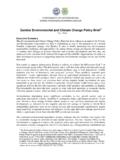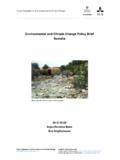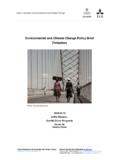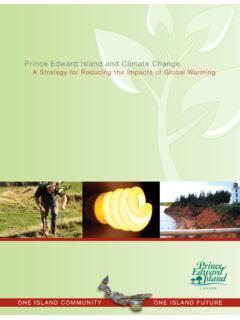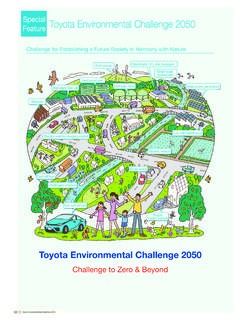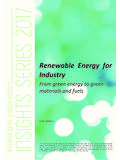Transcription of Environment and climate change policy brief- …
1 Sida's Helpdesk for Environment and climate change Contact: Olof Drakenberg Emelie Environment and climate change policy brief- Rwanda, final draft May 22 2013 This brief has been written in March by Olof Drakenberg and Emelie Cesar at Sida Helpdesk for Environment and climate change at the request of Per Bj rkman, Sida Stockholm and Joakim Molander, Embassy of Sweden in Kigali, Rwanda. This Environmental and climate change policy Brief aims to summarize the key environmental risks and opportunities for Rwanda to inform and stimulate discussions on future Swedish development cooperation.
2 Summary Rwanda is highly dependent on natural resources and agricultural growth is critical for pro-poor growth. Given very small land holdings, insufficient investments in soil and water conservation and Rwanda s topography, soil and nutrient erosion is a constraint to agricultural growth and a pressing environmental problem that also affect downstream countries. climate change is likely to add to 2 existing pressures including erosion through more intense rains. Conversion of wetlands, due to population displacements and encroachment in search of livelihood options, is another key environmental problem affecting water regulation, water purification, livelihoods and with negative impacts on downstream hydropower generation.
3 Economic diversification, improved soil and water management and increased use renewable energy sources are important for sustainable use of the country s natural resources and resilient communities. Environment and climate change issues are to a large degree integrated in key planning documents including the EDPRS, Vision 2020 and the National Strategy for Green growth and climate resilience. The latter should be mainstreamed into the on-going preparation of EDPRS II. Political ownership for managing Environment and climate change challenges appears to be strong and has received broad recognition interna tionally.
4 Rwanda is reputed for progress in mainstreaming poverty and Environment in planning processes1. However, ownership within productive sectors is low and implementation remains a key Domestic and international funds, including carbon finance are needed to finance the ambitious strategy for green growth and low carbon development. The institutional capacity is improving and there are signs of successful implementation of land reform and programmes for afforestation and soil protection. Despite a number positive steps taken environmental sustainability remains a challenge and it is unlikely that the targets for MDG 7 will be reached in 2015.
5 A number of improvements have been taken to stimulate private investments, not least in the mineral sector. Ensuring that trade-offs between private, short term economic interests and long term public interests is transparently and responsibly managed remains a challenge as the institutional capacity, both at central and decentralized level still is weak. It is suggested that Sweden should consider mainstreaming Environment and climate change in all relevant programs and sectors. Sweden could help to ensure that the private sector is well informed about Environment and climate change risks, regulations and opportunities and that civil society is empowered to hold government and business to account.
6 While efforts to increase productivity and value addition in natural resources sectors should be promoted, it is also important to stimulate job creation outside of natural resources sectors to reduce pressure on scarce resources. Introduction Rwanda is the most densely populated country in Africa and 45 % of the population live under the national poverty line. Poverty levels have fallen significantly in all regions but most in the Northern Province. The Southern Province remains the area with the highest levels of extreme is landlocked and is weakly integrated in the global economy.
7 However since joining the East African Community, Rwanda s trade with neighbouring countries have more than doubled. Population pressure coupled with inadequate management of forests and lands constrain economic growth and slow poverty reduction efforts by lowering agricultural yields and raising energy prices. climate change is expected to worsen existing stresses including poverty, land degradation, food insecurity, rising epidemics and natural disasters through rising temperatures and likely increase in rainfall. Recent floods occurred in Musanze, Nyabihu and Rubavu districts in April-May 2011 and the steep hilly topography makes Rwanda particularly vulnerable to Rwanda s energy 1 UNDP-UNEP Poverty Environment Initative,2011, PEI annual progress report 2010 2 GoR, ENR sector strategic plan final version 7-12-2012.
8 3 National institute of statistics of Rwanda, 2012, The third integrated household living conditions survey (IECV3) 4 Republic of Rwanda, 2011, National Strategy for climate change and low carbon development 3 security may be at risk since hydropower, which contributes about half of the electricity is vulnerable to greater evaporation and changes in rainfall and impacts of erosion. 1. Which are the key environmental problems, opportunities and their causes? Key environmental and natural resources problems Population growth, declining resources and poverty leads to over exploitation of natural resources.
9 The key environmental problems are land degradation, deforestation, wetland and biodiversity About 40% of land is classified by FAO as high erosion risk with about 37% requiring soil retention measures before and eroded soil reach Lake Victoria primarily through River Kagera that accounts for 1/3 of the river inflow in the lake and is a major contributor of water hyacinth growing urban areas are also creating problems of waste management (including electronic waste), air and water pollution. Another downstream effect is reduced potential for Rwandan hydropower generation due to siltation (reduced water storage) and lower water levels.
10 climate change is expected to increase vulnerability to existing stresses mentioned above, thus putting additional burdens notably on the rural poor. Rwanda, highly dependent on rain fed agriculture, existing problems with land degradation, low economic diversification and high poverty rates, is particularly vulnerable to climate change . The NAPA found that the eastern and southern provinces are most vulnerable to drought risks whereas the northern and western provinces are most vulnerable to intensive precipitation, floods and erosion. Expected impacts of climate change include: high degradation of arable land (erosion), desertification trend, lower lake levels and degradation of There is high certainty about higher temperature and more extreme weather (floods, drought etc) in the future.
